While some people are born with noses that perfectly fit their faces, many others find that their noses are out of proportion to the other features of their faces. This draws the attention immediately to the nose when they look in the mirror or at photos of themselves, or when others look at their faces.
Table of Contents
What is a Rhinoplasty
A Rhinoplasty, or “nose job”, is a procedure done to reshape the cartilage in the nose. It corrects a disproportioned nose shape to give a more natural look. When the nose is in proper proportion, the first feature others will see is the eyes, which increases the overall attractiveness of one’s face. Patients often complain about the hump on the bridge of their nose, not having a straight nose, and wanting to reduce their nose’s size. Not only is the procedure for improvement in aesthetic appearance, but it can also have a positive effect on some breathing issues. On occasion, a Mentoplasty (chin augmentation) will be paired with this procedure, to give the chin and nose a more harmonized and beautiful appearance.
Before and After Rhinoplasty Photos
Rhinoplasty Before and After Patient 1:
This 16-year-old patient had difficulty breathing through her nose. She was bothered by the bump on the bridge of her nose, and the asymmetry of the base of the nose. Dr. Russell performed an open rhinoplasty to correct a deviated septum, reduce the dorsal hump, and straighten the nasal bones. She loves her beautiful new nose that brings her facial features into balance. Now she is breathing easier than ever before!
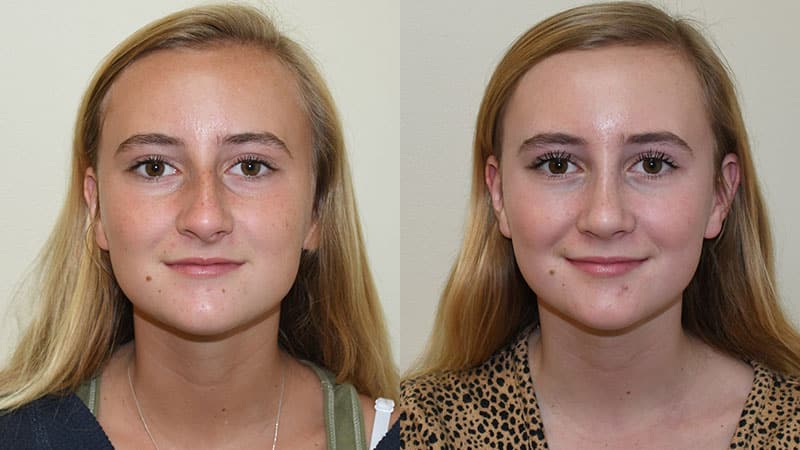
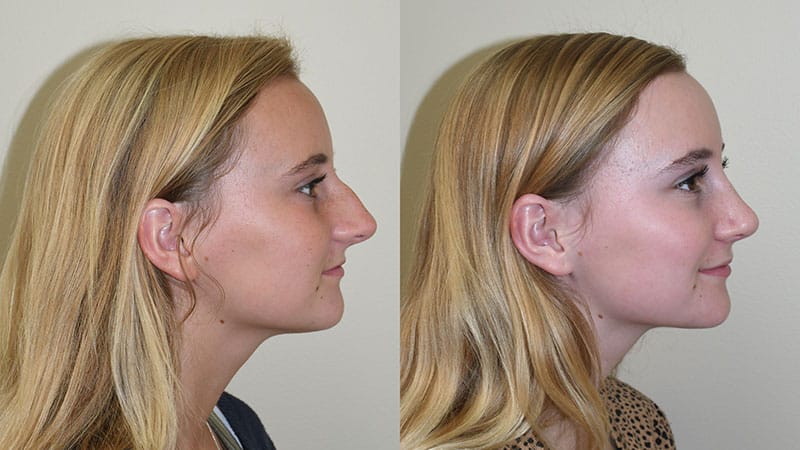
Rhinoplasty Before and After Patient 2:
This high school student was bothered by the dorsal hump on her nose. It drew excessive attention to her nose. She underwent a closed rhinoplasty by Dr. Russell just in time for prom! With her nose in balance with her other features, her eyes are now the focal point of her face.
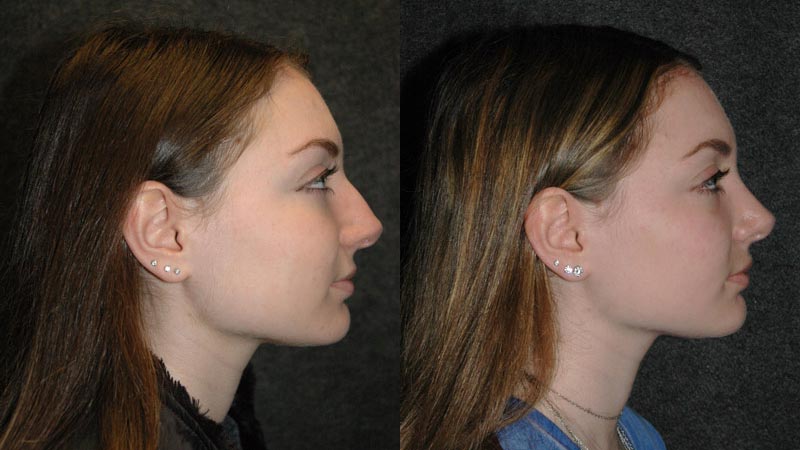
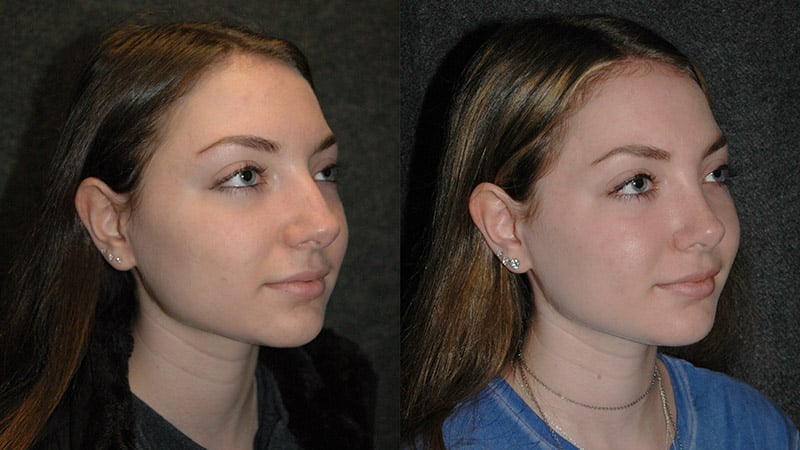
Rhinoplasty Before and After Patient 3:
This patient had felt for many years that her nose was too large for her face. She felt her nasal tip was too long and droopy. As a result, she underwent an open rhinoplasty with alar base reduction by Dr. Russell. Now she loves her new petite, cute nose that fits her face perfectly.

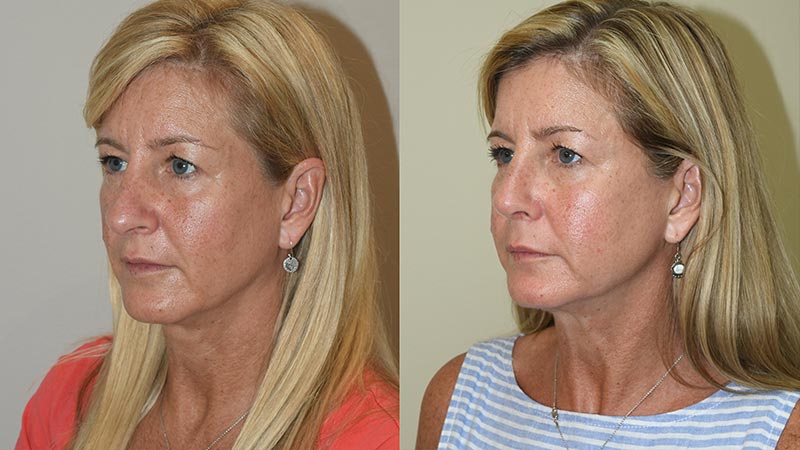
Rhinoplasty Before and After Patient 4:
This patient had a deviated septum that made it impossible to breathe through one side of her nose. It also made the lower half of her nose deviate to one side. She additionally had a dorsal hump and an asymmetric nasal tip that she wanted to fix. Dr. Russell performed an open rhinoplasty and septoplasty. In one operation, she is now able to breathe easily through her nose, and she loves how straight it is!


Rhinoplasty Before and After Patient 5:
This 20 year-old patient was dissatisfied with the appearance of her nose. She decided it was time to make a change. Dr. Russell removed the dorsal hump, straightened the nasal bones and septum, and refined the nasal tip. She now has the nose she has always wanted!
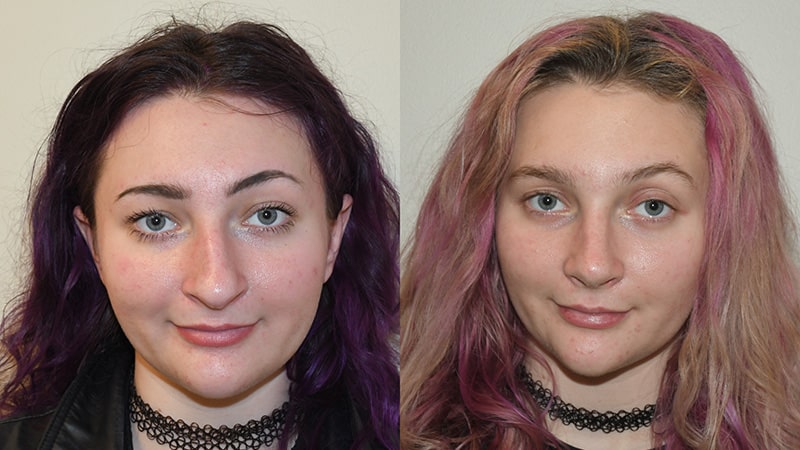
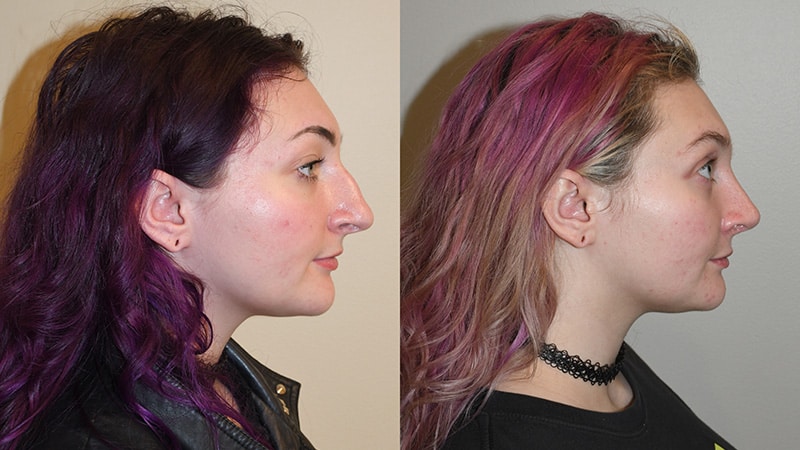
Why Would I Need a Nose Job?
The nose is a key factor when it comes to facial beauty. It affects the proportions of the face and how much your facial features balance together. With a nose job, an expert surgeon such as Dr. Joseph Russell, can bring the balance and harmony you’ve always wanted, even with the slightest of changes to the shape and structure.
What Features Can Be Improved?
The most common feature that patients seek to have corrected is the bump or hump on the bridge of the nose. This feature is called the dorsal hump, and dorsal hump reduction is a part of most rhinoplasties. Other common problems that are frequently addressed with rhinoplasty include:
- A wide or bulbous nasal tip
- A flat nasal tip
- A droopy nasal tip
- Wide nasal bones
- Large or wide nostrils
Rhinoplasty has evolved considerably in the past 40 years. Techniques in the past removed a considerable amount of tissue from the nose; while this approach initially produced very cute and attractive noses, there was very little support left in the nose, and over 10 to 20 years after surgery, the features of the nose would retract or collapse, producing an “operated-on” and unnatural appearance as patients reached their 40s and beyond. Today, we have learned that the best and longest-lasting results are obtained by making each surgery only as invasive as is necessary to achieve each patient’s aesthetic goals, and by ensuring that each patient’s nose has good support by removing as little tissue as possible and by placing cartilage grafts when necessary. To this end, rhinoplasty can be performed through either a “closed” approach or an “open” approach, the choice of which is determined by each patient’s current nasal structure and the areas of the nose he or she wants to have refined. Closed and open approaches are discussed below.
Who Should Get a Rhinoplasty?
It is important to note, first and foremost, that Rhinoplasties are not needed by everyone. It is common today for someone to see their picture in a selfie or video chat, and feel that their nose is large or distorted, while in reality, it is the closeness to the camera that is the problem. This can be determined by patients while reviewing their true-proportion photos that are taken during their consultations.
The most common nose job patients are adolescents and adults, who are healthy and non-smokers, and are unhappy with how their noses look or have nasal problems. Patients should also have realistic expectations about the outcome of the procedure and understand that this procedure has limits of what changes can be achieved based on each person’s individual anatomy.
What Should You Expect from a Consultation?
At your consultation, Dr. Russell will evaluate the external and internal structure of your nose. He will note your skin thickness, the underlying bone and cartilage strength, and nasal function. These factors all play important roles in deciding which surgical techniques are needed to accomplish the changes you desire.
While it’s important for your surgeon to examine your nose, it’s also vitally important for you to express how you want your nose to appear. Dr. Russell will take pictures of your nose during the consultation and use morphing software to illustrate the changes that are possible with your individual nose, and the two of you will work to determine which changes should be made to get the result you want. What you want your nose to look like has just as much impact on what Dr. Russell will do during surgery as the current structure of your nose does.
How is it Performed?
Dr. Russell performs all of his rhinoplasty procedures in the operating room under general anesthesia at a local hospital or outpatient surgery center. Rhinoplasty is an outpatient procedure, and patients can expect to go home an hour or two after the procedure has finished. Rhinoplasties can be performed with either the “open” or “closed” techniques.
Open Rhinoplasty
If it is an “open” procedure, which is the most common, Dr. Russell will create a tiny incision on the bottom of the nose between the nostrils, to lift the skin in order to access the tissues. Once the deeper tissues are exposed, Dr. Russell uses specialized rhinoplasty instruments to remove excess bone and cartilage, narrow the nose, and add more cartilage if necessary. If grafting is needed, cartilage is taken from the patient’s nasal septum (most common), ear (in a hidden location), or rib. If ear or rib cartilage is expected to be needed for your surgery, Dr. Russell will discuss this with the patient during the consultation. Once the changes to the deeper structure are completed, the incision is carefully closed to ensure its final appearance will be nearly invisible.
Closed Rhinoplasty
Contrarily, the “closed” procedure, all of the incisions are made inside the nose to access the deeper tissues, and then proceeds in a similar fashion as an open rhinoplasty. Every procedure is customized to each patient’s individual anatomy and desired appearance. Whether an open or closed approach is best for each patient’s goals will be discussed during the consultation.
Alar Base Reduction
Finally, if the nostrils are excessively large or wide and the patient wants them reduced, a separate procedure, called an alar base reduction, can be performed to bring the nostrils into harmony with the rest of the nose and face. An alar base reduction can be performed with either closed or open rhinoplasty.
Once the bone and cartilage of the nose are reshaped, the incisions are closed, and a cast is placed on the nose to stabilize the new shape of the nose. This cast is left in place and then removed 1 week after surgery.
- 5 Interesting Facts About Rhinoplasty You Likely Didn’t Know
- Functional Rhinoplasty
- What You Need to Know About the Nose
- Dealing with sinus pressure and pain in South Carolina Lowcountry
- 14 celebrity noses: Whose schnoz do you share?
Differences Between Open and Closed
In an open rhinoplasty, most of the incisions for the surgery are inside the nose, but one small incision across the bottom of the nose (the columella) is required. This is the ideal approach for someone who needs a moderate or large amount of work done on the nasal tip, or who has a very large nose. The open rhinoplasty approach provides the ability to make large changes to the nose in a very controlled fashion, so while the duration and extent of swelling are usually more compared to closed rhinoplasty, this approach provides superior outcomes in complex cases.
In a closed rhinoplasty, all of the incisions for the surgery are made inside of the nose. It can be considered more of a minimally invasive technique for rhinoplasty compared to open rhinoplasty. The extent of surgery is less than in open rhinoplasty, and therefore the healing process is easier and quicker. Closed rhinoplasty is the ideal approach for someone who has a normal-sized nose but with a large bump or hump on the bridge of the nose (the dorsal hump) that he or she wants to be removed, and who otherwise wants no or minimal refinement to the nasal tip.
How Long Is Recovery?
Recovery is most accurately viewed as a series of stages, as described below. However, from a practical standpoint, patients need to plan to be off from work or school for the first week while the cast is in place. Once the cast is removed at 1 week, patients can return to work or school, and at 2 weeks after surgery, patients can resume normal activities. Patients can realistically expect 90% of the swelling to disperse after a few weeks.
- Week 1: Recovery from surgery begins; the cast will be removed at the end of the first week
- Week 2: 80% of the swelling of the nose resolves by the end of this week
- Weeks 3-8: An additional 10% the swelling resolves during this time; each week the nose looks more refined
- Weeks: 9-52: The final 10% of swelling resolves over the course of a year; subtle refinement of the nose occurs as this last bit of swelling resolves.
During the first few days of rhinoplasty recovery, you should ideally have someone there to help you take care of yourself, as proper aftercare is key to a successful result. There will be some swelling and discomfort following surgery, and you may have some bruising as well. You will need to sleep with your head elevated during the first few days to help control swelling. Medication will be prescribed to help keep you comfortable during recovery. Vigorous exercise will need to be postponed for 2 weeks.
Detailed post-op instructions are provided in a printed form prior to surgery for all of our Rhinoplasty patients.
Is There an Age Limit for Rhinoplasty?
Rhinoplasty is generally not performed while the nose is still growing, but can usually be performed after puberty, as growth nears completion. Teenage patients who want a nose job often have the procedure a year or two before college and gain a boost of self-confidence as they head into adulthood. If a nose deformity is severe and causing difficulty breathing, such as can occur from a car accident or sports injury, younger patients may benefit from having surgery to correct the deformity sooner rather than later.
There is no upper age limit for rhinoplasty. As we age, the nasal tip begins to droop, which makes the nose longer and contributes to an aged appearance. For this reason, some patients will combine rhinoplasty with another procedure such as a facelift or browlift for maximal facial rejuvenation.
Frequently Asked Rhinoplasty Questions
When will my swelling go down?
You may experience swelling for months to come, after the Rhinoplasty procedure, because the tissues in the nose heal very slowly. In the span of the first couple weeks, most of the swelling will go down, however, the remaining swelling will go down gradually, throughout the rest of the year.
Should I get a nose job?
If your thoughts of getting a nose job stem from peer pressure and such, then no. If you aren’t sure about going through with the surgery, you should do research and consult Dr. Russell. Be sure this is a procedure you are completely interested in, as this procedure will produce permanent results.
What risks come with a Rhinoplasty?
All surgeries carry risk. Specific to rhinoplasty, the risks include excessive bleeding, scarring, infection, asymmetry, breathing problems, and unsatisfactory aesthetic outcomes. Dr. Russell is highly trained and skilled in this procedure and will make the very best effort to prevent these complications, and promptly address any that do occur.
Will I have scars?
All incision-based surgeries will result in scarring. In an Open Rhinoplasty, the scarring is minimal and is not easily noticed. However, in Closed Rhinoplasty the incisions are hidden inside the nose, so scars will be impossible to spot.
Schedule Your Nose Job Consultation
If you are interested in a closed or open rhinoplasty in Charleston, SC, consider Dr. Joseph Russell. He is a board-certified facial plastic surgeon who has been trained by one of the world’s premier facial surgeons in New York City, and is known for his own meticulous attention to detail and compassionate care for his patients. Please contact our office at (843) 576-3302 to schedule a consultation.
